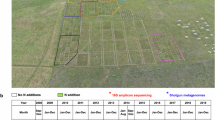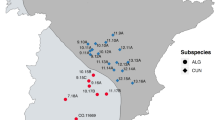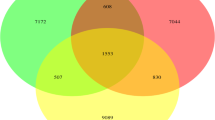Abstract
Coarse woody debris is an important biomass pool in forest ecosystems that numerous groups of insects have evolved to take advantage of. These insects are ecologically important and represent useful natural analogs for biomass to biofuel conversion. Using a range of molecular approaches combined with microelectrode measurements of oxygen, we have characterized the gut microbiome and physiology of Odontotaenius disjunctus, a wood-feeding beetle native to the eastern United States. We hypothesized that morphological and physiological differences among gut regions would correspond to distinct microbial populations and activities. In fact, significantly different communities were found in the foregut (FG), midgut (MG)/posterior hindgut (PHG) and anterior hindgut (AHG), with Actinobacteria and Rhizobiales being more abundant toward the FG and PHG. Conversely, fermentative bacteria such as Bacteroidetes and Clostridia were more abundant in the AHG, and also the sole region where methanogenic Archaea were detected. Although each gut region possessed an anaerobic core, micron-scale profiling identified radial gradients in oxygen concentration in all regions. Nitrogen fixation was confirmed by 15N2 incorporation, and nitrogenase gene (nifH) expression was greatest in the AHG. Phylogenetic analysis of nifH identified the most abundant transcript as related to Ni–Fe nitrogenase of a Bacteroidetes species, Paludibacter propionicigenes. Overall, we demonstrate not only a compartmentalized microbiome in this beetle digestive tract but also sharp oxygen gradients that may permit aerobic and anaerobic metabolism to occur within the same regions in close proximity. We provide evidence for the microbial fixation of N2 that is important for this beetle to subsist on woody biomass.
Similar content being viewed by others
Log in or create a free account to read this content
Gain free access to this article, as well as selected content from this journal and more on nature.com
or
Accession codes
References
Benjamini Y, Hochberg Y . (1995). Controlling the false discovery rate: a practical and powerful approach to multiple testing. J R Stat Soc Ser B 57: 289–300.
Bignell DE, Eggleton P . (1995). On the elevated intestinal pH of higher termites (Isoptera: Termitidae). Insect Soc 42: 57–69.
Bowen JL, Ward BB, Morrison HG, Hobbie JE, Valiela I, Deegan LA et al (2011). Microbial community composition in sediments resists perturbation by nutrient enrichment. ISME J 5: 1540–1548.
Breznak JA . (2000). Ecology of prokaryotic microbes in the guts of wood- and litter-feeding termites. In Abe T, Bignell DE, Higashi M, (eds). Termites: Evolution, Sociality, Symbioses, Ecology. Kluwer Academic Publishers: Dordrecht, NJ, USA, pp 209–231.
Brodie EL, Desantis TZ, Joyner DC, Baek SM, Larsen JT, Andersen GL et al (2006). Application of a high-density oligonucleotide microarray approach to study bacterial population dynamics during uranium reduction and reoxidation. Appl Environ Microbiol 72: 6288–6298.
Brune A, Emerson D, Breznak JA . (1995). The termite gut microflora as an oxygen sink: microelectrode determination of oxygen and pH gradients in guts of lower and higher termites. Appl Environ Microbiol 61: 2681–2687.
Brune A, Kühl M . (1996). pH profiles of the extremely alkaline hindguts of soil-feeding termites (Isoptera: Termitidae) determined with microelectrodes. J Insect Physiol 42: 1121–1127.
Brune A, Ohkuma M . (2011). Role of the termite gut microbiota in symbiotic digestion. In Bignell DE, Roisin Y, Lo N (eds). Biology of Termites: A Modern Synthesis. Springer: Netherlands, pp 439–475.
Dahllöf I, Baillie H, Kjelleberg S . (2000). rpoB-based microbial community analysis avoids limitations inherent in 16S rRNA gene intraspecies heterogeneity. Appl Environ Microbiol 66: 3376–3380.
Dillon RJ, Dillon VM . (2004). The gut bacteria of insects: nonpathogenic interactions. Annu Rev Entomol 49: 71–92.
Ebert A, Brune A . (1997). Hydrogen concentration profiles at the oxic–anoxic interface: a microsensor study of the hindgut of the wood-feeding lower termite Reticulitermes flavipes (Kollar). Appl Environ Microbiol 63: 4039–4046.
Faith D . (1992). Conservation evaluation and phylogenetic diversity. Biol Conserv 61: 1–10.
Fallingborg J . (1999). Intraluminal pH of the human gastrointestinal tract. Dan Med Bull 46: 183–196.
Goldfarb KC, Karaoz U, Hanson CA, Santee CA, Bradford MA, Treseder KK et al (2011). Differential growth responses of soil bacterial taxa to carbon substrates of varying chemical recalcitrance. Front Microbiol 2: 94.
Gouy M, Guindon S, Gascuel O . (2010). SeaView version 4: a multiplatform graphical user interface for sequence alignment and phylogenetic tree building. Mol Biol Evol 27: 221–224.
Gray IE . (1946). Observations on the life history of the horned Passalus. Am Midl Nat 35: 728–746.
Gronow S, Munk C, Lapidus A, Nolan M, Lucas S, Hammon N et al (2011). Complete genome sequence of Paludibacter propionicigenes type strain (WB4). Stand Genom Sci 4: 36–44.
Hardy OJ . (2008). Testing the spatial phylogenetic structure of local communities: statistical performances of different null models and test statistics on a locally neutral community. J Ecol 96: 914–926.
Hongoh Y, Moriya Ohkuma, Kudo T . (2003). Molecular analysis of bacterial microbiota in the gut of the termite Reticulitermes speratus (Isoptera; Rhinotermitidae). FEMS Microbiol Ecol 44: 231–242.
Horner-Devine MC, Bohannan BJM . (2006). Phylogenetic Clustering and Overdispersion in Bacterial Communities. Ecology 87: 100–108.
Ivanov II, Atarashi K, Manel N, Brodie EL, Shima T, Karaoz U et al (2009). Induction of intestinal Th17 cells by segmented filamentous bacteria. Cell 139: 485–498.
Jo JH, Lee DS, Park D, Park JM . (2008). Biological hydrogen production by immobilized cells of Clostridium tyrobutyricum JM1 isolated from a food waste treatment process. Biores Technol 99: 6666–6672.
Kaneko T . (2002). Complete genomic sequence of nitrogen-fixing symbiotic bacterium Bradyrhizobium japonicum USDA110. DNA Res 9: 189–197.
Kaufman MG, Walker ED, Odelson DA, Klug MJ . (2000). Microbial community ecology & insect nutrition. Am Entomol 46: 173–185.
Kembel SW, Cowan PD, Helmus MR, Cornwell WK, Morlon H, Ackerly DD et al (2010). Picante: R tools for integrating phylogenies and ecology. Bioinformatics 26: 1463–1464.
Klass K-D, Nalepa C, Lo N . (2008). Wood-feeding cockroaches as models for termite evolution (Insecta: Dictyoptera): Cryptocercus vs Parasphaeria boleiriana. Mol Phylogenet Evol 46: 809–817.
Leidy J . (1852). Description of some nematoid entozoa infesting insects. Philadelphia Proc Acad Natl Sci 5: 100–103.
Leschine SB . (1995). Cellulose degradation in anaerobic environments. Annu Rev Microbiol 49: 399–426.
Leschine SB, Canale-Parola E . (1989). Carbon cycling by cellulose-fermenting nitrogen-fixing bacteria. Adv Space Res 9: 149–152.
Letunic I, Bork P . (2007). Interactive Tree Of Life (iTOL): an online tool for phylogenetic tree display and annotation. Bioinformatics 23: 127–128.
Lichtwardt RW, White MM, Cafaro MJ, Misra JK . (1999). Fungi associated with passalid beetles and their mites. Mycologia 91: 694–702.
Lilburn TG, Kim KS, Ostrom NE, Byzek KR, Leadbetter JR, Breznak JA . (2001). Nitrogen fixation by symbiotic and free-living spirochetes. Science (New York, NY) 292: 2495–2498.
Livak KJ, Schmittgen TD . (2001). Analysis of relative gene expression data using real-time quantitative PCR and the 2(−Delta Delta C(T)) Method. Methods 25: 402–408.
Lo Y-C, Saratale GD, Chen W-M, Bai M-D, Chang J-S . (2009). Isolation of cellulose–hydrolytic bacteria and applications of the cellulolytic enzymes for cellulosic biohydrogen production. Enzyme Microb Technol 44: 417–425.
Machida M, Kitade O, Miura T, Matsumoto T . (2001). Nitrogen recycling through proctodeal trophallaxis in the Japanese damp-wood termite Hodotermopsis japonica (Isoptera, Termopsidae). Insect Soc 48: 52–56.
Mechichi T, Labat M, Patel BKC, Woo THS, Thomas P, Garcia J-L . (1999). Clostridium methoxybenzovorans sp. nov., a new aromatic o-demethylating homoacetogen from an olive mill wastewater treatment digester. Int J Syst Bacteriol 49: 1201–1209.
Moran NA . (2007). Symbiosis as an adaptive process and source of phenotypic complexity. Proc Natl Acad Sci USA 104: 8627–8633.
Nardi JB, Bee CM, Miller LA, Nguyen NH, Suh S-O, Blackwell M . (2006). Communities of microbes that inhabit the changing hindgut landscape of a subsocial beetle. Arthropod Struct Dev 35: 57–68.
Nedashkovskaya OI . (2004). Cellulophaga pacifica sp. nov. Int J Syst Evol Microbiol 54: 609–613.
Nguyen NH, Suh S-O, Marshall CJ, Blackwell M . (2006). Morphological and ecological similarities: wood-boring beetles associated with novel xylose-fermenting yeasts, Spathaspora passalidarum gen. sp. nov. and Candida jeffriesii sp. nov. Mycol Res 110: 1232–1241.
Ohkuma M . (2003). Termite symbiotic systems: efficient bio-recycling of lignocellulose. Appl Microbiol Biotechnol 61: 1–9.
Ohkuma M, Brune A . (2011). Diversity, Structure, and Evolution of the Termite Gut Microbial Community. In Bignell DE, Roisin Y, Lo N (eds). Biology of termites: a modern synthesis Springer: Netherlands, pp 413–438.
Ohkuma M, Sato T, Noda S, Ui S, Kudo T, Hongoh Y . (2007). The candidate phylum ‘Termite Group 1’ of bacteria: phylogenetic diversity, distribution, and endosymbiont members of various gut flagellated protists. FEMS Microbiol Ecol 60: 467–476.
Pearse AS, Patterson MT, Rankin JS, Wharton GW . (1936). The ecology of Passalus cornutus Fabricius, a beetle which lives in rotting logs. Ecol Monogr 6: 455–490.
Poly F, Monrozier LJ, Bally R . (2001). Improvement in the RFLP procedure for studying the diversity of nifH genes in communities of nitrogen fixers in soil. Res Microbiol 152: 95–103.
Reid NM, Lloyd-Jones G . (2009). Symbiotic nitrogen fixation in the New Zealand dampwood termite (Stolotermes ruficeps). N Z J Ecol 33: 90–95.
Schmitt-Wagner D, Brune A . (1999). Hydrogen profiles and localization of methanogenic activities in the highly compartmentalized hindgut of soil-feeding higher termites (Cubitermes spp.). Appl Environ Microbiol 65: 4490–4496.
Shi W, Syrenne R, Sun J-Z, Yuan JS . (2010). Molecular approaches to study the insect gut symbiotic microbiota at the ‘omics’ age. Insect Sci 17: 199–219.
Slaytor M . (1992). Cellulose digestion in termites and cockroaches: What role do symbionts play? Comp Biochem Phys B 103: 775–784.
Stamatakis A, Ludwig T, Meier H . (2005). RAxML-III: a fast program for maximum likelihood-based inference of large phylogenetic trees. Bioinformatics 21: 456–463.
Stingl U, Maass A, Radek R, Brune Andreas . (2004). Symbionts of the gut flagellate Staurojoenina sp. from Neotermes cubanus represent a novel, termite-associated lineage of Bacteroidales: description of ‘Candidatus Vestibaculum illigatum’. Microbiology 150: 2229–2235.
Suh S-O, Marshall CJ, Mchugh JV, Blackwell M . (2003). Wood ingestion by passalid beetles in the presence of xylose-fermenting gut yeasts. Mol Ecol 12: 3137–3145.
Swofford DL . (1998). PAUP*: phylogenetic analysis using parsimony, ver. 4.0b10. Sinauer Associates, Sunderland, MA, USA.
The R Development Core Team (2010) R: A Language and Environment for Statistical Computing. R Foundation for Statistical Computing: Vienna, Austria, ISBN 3-900051-07-0. http://www.r-project.org/.
Thompson J . (1997). The CLUSTAL_X windows interface: flexible strategies for multiple sequence alignment aided by quality analysis tools. Nucleic Acids Res 25: 4876–4882.
Tokuda G, Watanabe H . (2007). Hidden cellulases in termites: revision of an old hypothesis. Biol Lett 3: 336–339.
USDA (2010), National Report on Sustainable Forests—2010. United States Department of Agriculture: Washington, DC, USA.
Valencia A, Bustillo AE, Ossa GE, Chrispeels MJ . (2000). Alpha-amylases of the coffee berry borer (Hypothenemus hampei) and their inhibition by two plant amylase inhibitors. Insect Biochem Mol 30: 207–213.
Webb CO, Ackerly DD, McPeek SW, Donoghue MJ . (2002). Phylogenies and Community Ecology. Annu Rev Ecol Syst 33: 475–505.
Webb CO, Ackerly DD, Kembel SW . (2008). Phylocom: software for the analysis of phylogenetic community structure and trait evolution. Bioinformatics 24: 2098–2100.
Wood TG . (1986). The biology, physiology, and ecology of termites. In Economic Impact and Control of Social Insects. Vinson SB, (ed). Praeger Publications: New York, NY, USA, pp 1–68.
Zhang N, Suh S-O, Blackwell M . (2003). Microorganisms in the gut of beetles: evidence from molecular cloning. J Invertebr Pathol 84: 226–233.
Acknowledgements
This work was supported by the Department of Energy, Office of Biological and Environmental Research, Genomic Sciences program through the Lawrence Livermore National Laboratory Biofuels Scientific Focus Area (SFA) award SCW1039. Part of this work (ELB, JAC-N, UK, GLA) was performed at Lawrence Berkeley National Laboratory under the Department of Energy contract number DE-AC02-05CH11231. Contributions of JPR are under the auspices of the US DOE at LLNL (DE-AC52-07NA27344). Additional support was provided from the NSF-GRFP program to NHN, the LSU Boyd Professor Research fund to MB, and JAC-N was also supported in part by a grant from ‘Consejo Nacional de Ciencia y Tecnología’ (CONACyT, Mexico). We thank Hector Urbina for collection of beetles; George Stanley for help in conducting the nitrogen uptake experiments; Doug Wendell and Gail Ackermann form the QIIME-DB for their support with the submission of the sequencing data to the EBI.
Author information
Authors and Affiliations
Corresponding authors
Ethics declarations
Competing interests
The authors declare no conflict of interest.
Additional information
Supplementary Information accompanies this paper on The ISME Journal website
Rights and permissions
About this article
Cite this article
Ceja-Navarro, J., Nguyen, N., Karaoz, U. et al. Compartmentalized microbial composition, oxygen gradients and nitrogen fixation in the gut of Odontotaenius disjunctus. ISME J 8, 6–18 (2014). https://doi.org/10.1038/ismej.2013.134
Received:
Revised:
Accepted:
Published:
Issue date:
DOI: https://doi.org/10.1038/ismej.2013.134
Keywords
This article is cited by
-
Functional similarity, despite taxonomical divergence in the millipede gut microbiota, points to a common trophic strategy
Microbiome (2024)
-
The pivotal roles of gut microbiota in insect plant interactions for sustainable pest management
npj Biofilms and Microbiomes (2023)
-
Nitrogen Fixation and Diazotrophic Community in Plastic-Eating Mealworms Tenebrio molitor L
Microbial Ecology (2023)
-
Structural basis of lignocellulose deconstruction by the wood-feeding anobiid beetle Nicobium hirtum
Journal of Wood Science (2022)
-
Gut symbiotic bacteria are involved in nitrogen recycling in the tephritid fruit fly Bactrocera dorsalis
BMC Biology (2022)



